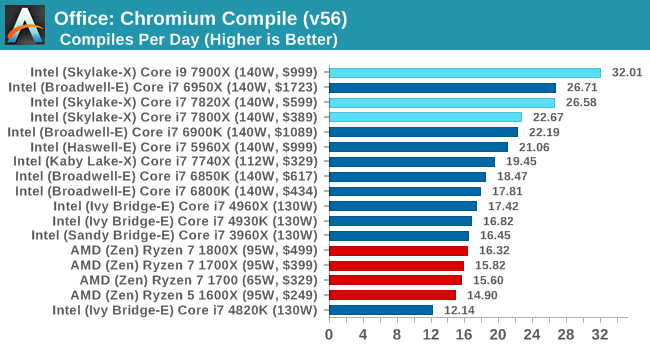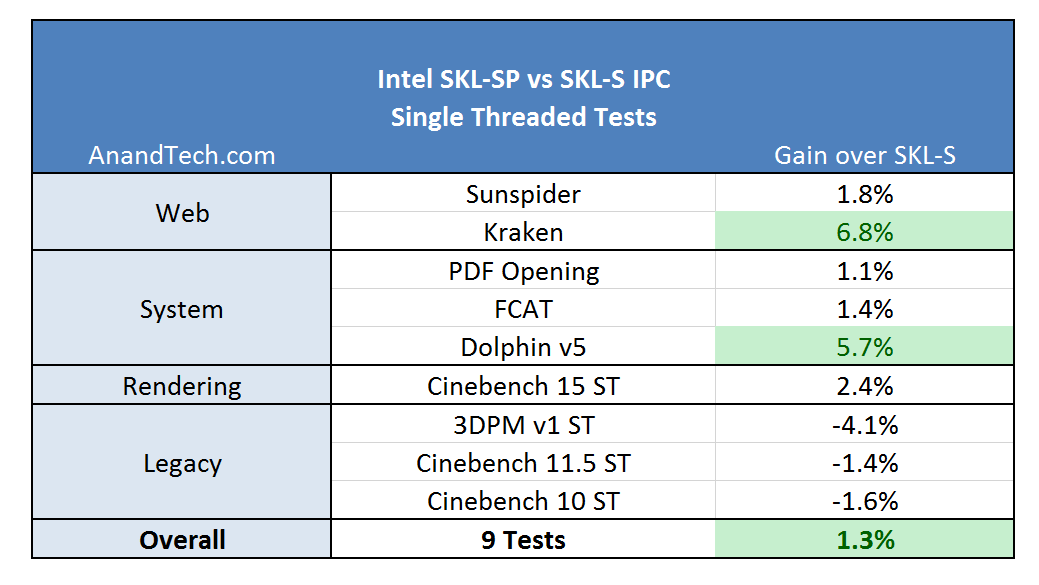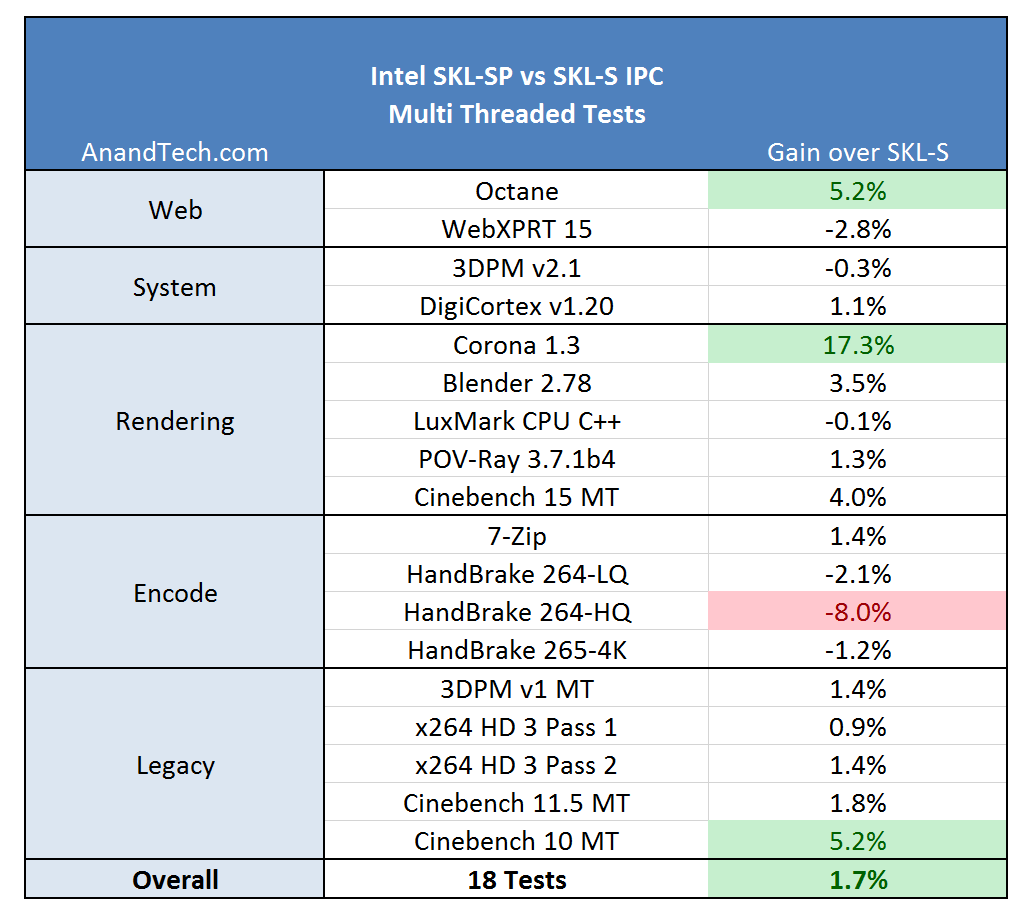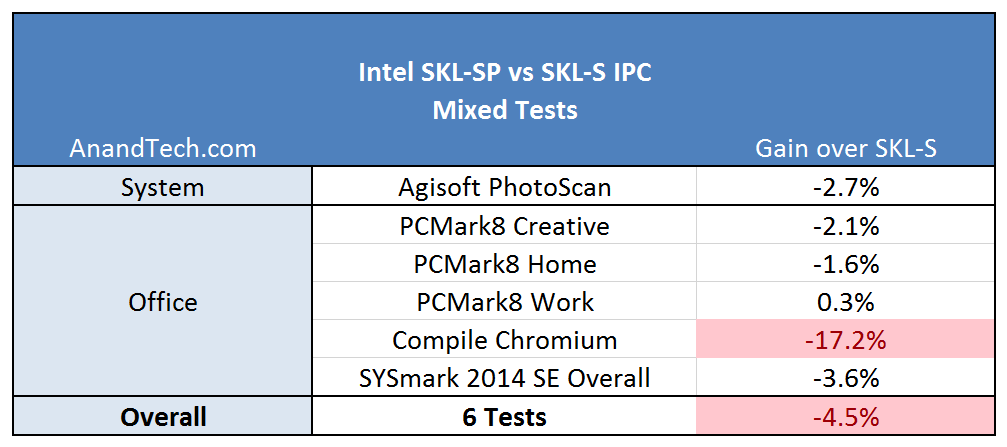The Intel Skylake-X Review: Core i9 7900X, i7 7820X and i7 7800X Tested
by Ian Cutress on June 19, 2017 9:01 AM ESTComparing Skylake-S and Skylake-X/SP Performance Clock-for-Clock
If you’ve read through the full review up to this point (and kudos), there should be three things that stick in the back of your mind about the new Skylake-SP cores: Cache, Mesh and AVX512. These are the three main features that separate the consumer grade Skylake-S core from this new core, and all three can have an impact in clock-for-clock performance. Even though the Skylake-S and the Skylake-SP are not competing in the same markets, it is still poignant to gather how much the changes affect the regular benchmark suite.
For this test, we took the Skylake-S based Core i5-6600 and the Skylake-SP based Core i9-7900X and ran them both with only 4 cores, no hyperthreading, and 3 GHz on all cores with no Turbo active. Both CPUs were run in high performance modes in the OS to restrict any time-to-idle, so it is worth noting here that we are not measuring power. This is just raw throughput.
Both of these cores support different DRAM frequencies, however: the i5-6600 lists DDR4-2133 as its maximum supported frequency, whereas the i9-7900X will run at DDR4-2400 at 2DPC. I queried a few colleagues as to what I should do here – technically the memory support is an extended element of the microarchitecture, and the caches/uncore/untile will be running at different frequencies, so how much of the system support should be chipped away for parity. The general consensus was to test with the supported frequencies, given this is how the parts ship.
For this analysis, each test was broken down in two ways: what sort of benchmark (single thread, multi-thread, mixed) and what category of benchmark (web, office, encode).
For the single threaded tests, results were generally positive. Kraken enjoyed the L2, and Dolphin emulation had a good gain as well. The legacy tests did not fair that great: 3DPM v1 has false sharing, which is likely taking a hit due to the increased L2 latency.
On the multithreaded tests, the big winner here was Corona. Corona is a high-performance renderer for Autodesk 3ds Max, showing that the larger L2 does a good job with its code base. The step back was in Handbrake – our testing does not implement any AVX512 code, but the L3 victim cache might be at play here over the L3 inclusive cache in SKL-S.
The mixed results are surprising: these tests vary with ST and MT parts to their computation, some being cache sensitive as well. The big outlier here is the compile test, indicating that the Skylake-SP might not be (clock for clock) a great compilation core. This is a result we can trace back to the L3 again, being a smaller non-inclusive cache. In our results database, we can see similar results when comparing a Ryzen 7 1700X, an 8-core 95W CPU with 16MB of L3 victim cache, is easily beaten by a Core i7-7700T, with 4 cores at 35W but has 8MB of inclusive L3 cache.
If we treat each of these tests with equal weighting, the overall result will offer a +0.5% gain to the new Skylake-SP core, which is with the margin of error. Nothing too much to be concerned about for most users (except perhaps people who compile all day), although again, these two cores are not in chips that directly compete. The 10-core SKL-SP chip still does the business on compiling:

If all these changes (minus AVX512) offer a +0.5% gain over the standard Skylake-S core, then one question worth asking is what was the point? The answer is usually simple, and I suspect involves scaling (moving to chips with more cores), but also customer related. Intel’s big money comes from the enterprise, and no doubt some of Intel’s internal metrics (as well as customer requests) point to a sizeable chunk of enterprise compute being L2 size limited. I’ll be looking forward to Johan’s review on the enterprise side when the time comes.













264 Comments
View All Comments
jjj - Monday, June 19, 2017 - link
The 10 cores die is clearly 320+mm2 not 308mm2. The 308mm figure rounds down the mm based on those GamerNexus pics. From there, you slightly underestimate the size of other 2 die.Sarah Terra - Monday, June 19, 2017 - link
Fair point but what I take from this review is that you are going to be spending pretty much double the cost or higher of ryzen for a proc that will have a 30% larger power envelope if you want higher performance. Intel is scrambling here, well done AMD.jjj - Monday, June 19, 2017 - link
With 8 cores and up, thermal is a big issue when you OC Skylake X.. Power also to some extent.The 6 cores looks interesting vs the 7700k but not so much vs anything else. CPU+mobo gets you north of 600$ and that's a lot. If it had all the PCIe lanes enabled, there would be that but ,while plenty will buy it, it makes no sense to. And ofc there should be a Coffee Lake 6 cores soon , we'll see how it is priced- in consumer 6 cores with 2 mem chans is fine.
More than 6 cores are priced way too high and , if you need many cores, you buy for MT not ST so ST clocks are less relevant.
Intel moving in the same direction as AMD on the cache size front is interesting- larger L2 and smaller L3. Now they have "huge cache and memory latency issues"" just like Ryzen lol.
W/e, Intel's pricing is still far too high and this platform remains of minimal relevance.
ddriver - Monday, June 19, 2017 - link
Funny thou, when Ryzen under-performed in games that was no reason to not publish gaming benches, in fact being the platform's main weakness there was actually emphasis put on that... but when it comes to intel we gotta have special treatment... Let's hear it for objectivity!Granted the 7800X finally brings something of relatively decent value, but still no good reason to justify the purchase unless one insists on an intel product, for the brand, for thunderbolt or hypetane support.
"To play it safe, invest in the Core i9-7900X today."
Really? With Threadripper incoming in a matter of weeks? For less than 1000$ you will get 16 zen cores. It will definitely beat the 7900X by a decent margin in terms of performance, plus the massive I/O capabilities and also ECC support, which I'd say is vital. That just doesn't sound like a honest recommendation. Not surprising in the least.
ddriver - Monday, June 19, 2017 - link
Also, on top of that we have launch prices for Ryzen rather than current prices. Looks like a rather open attempt to diminish AMD's platform value.Ian Cutress - Tuesday, June 20, 2017 - link
We've always posted manufacturer MSRPs in our CPU charts. There has been no official price drop from AMD; if you're seeing lower, it's being run from the distributor level.On the TR issue, we basically haven't tested it and don't know the price. Lots of variables in the air, which is why the words are /if you want to play it safe/. Safe being the key word there.
ddriver - Tuesday, June 20, 2017 - link
Dunno Ian, in my book this sounds more like hasty than safe. The safe thing would be to wait out. Even without the incipient TR launch, early adoption is rather unsafe on its own. As it is, it sounds more like an attempt to dupe people into spending their money on intel in the eve of the launch of a superior value and performance product from a direct (and sole) competitor.It is true that nothing is still officially known about TR, but based on the ryzen marketing strategy and performance we can make safe and accurate speculations. I expect to see the top TR chip launched at 999$ offering at the very least 30% of performance advantage over the 7900X in a similar or slightly higher thermal budget, of course in workloads that can scale nicely up with the core count.
Comparing the 7900X to the 1800X, we have ~35% performance advantage for 205% the price and 150% the power usage. Based on that, it is a safe bet that TR is going to shine.
fanofanand - Monday, June 26, 2017 - link
Ian is a scientist, the less guessing the better. Give him an opportunity to review TR before giving suggestions. Doesn't that seem fair?t.s - Tuesday, June 20, 2017 - link
Play it safe? Really?? Please. As if everyone in this world's stupid.Ranger1065 - Wednesday, June 21, 2017 - link
There has never been a better time to give Intel the middle finger.